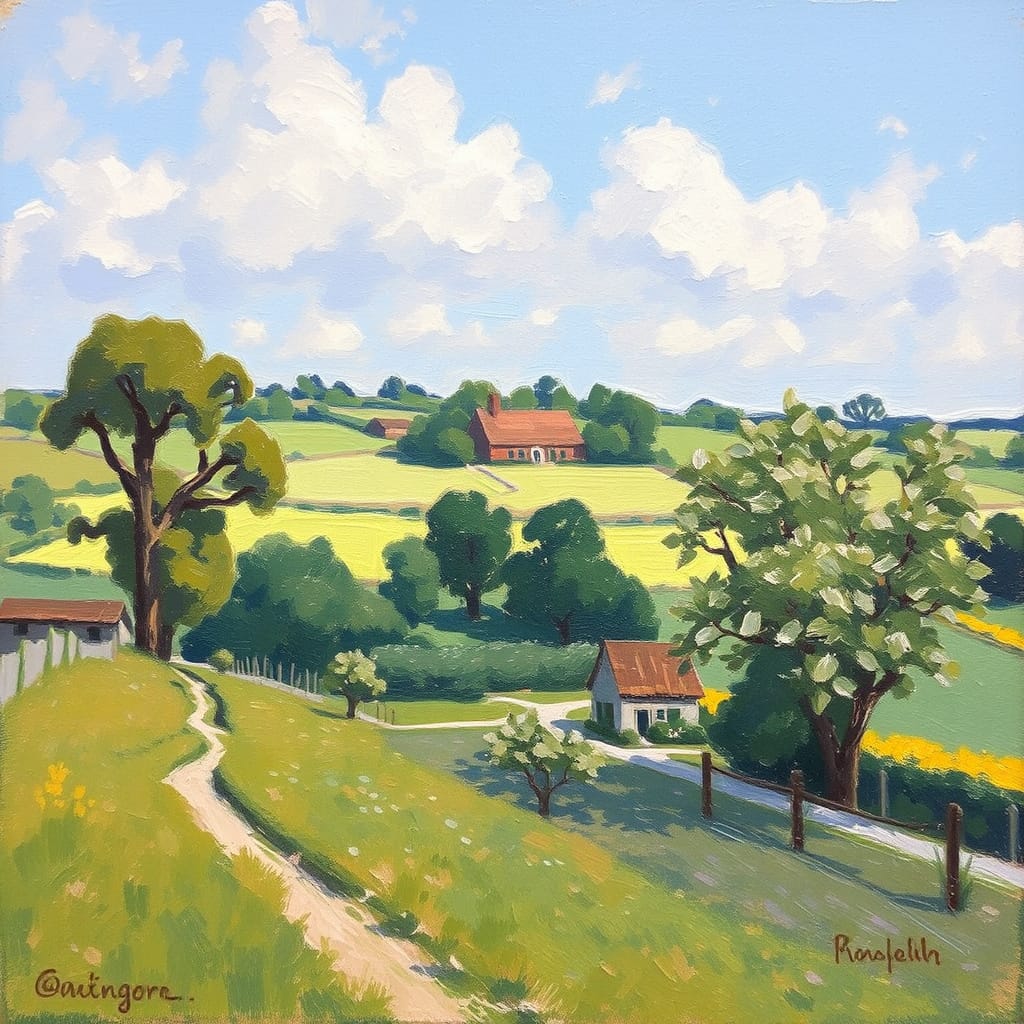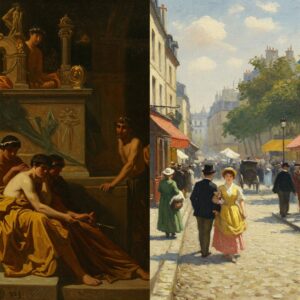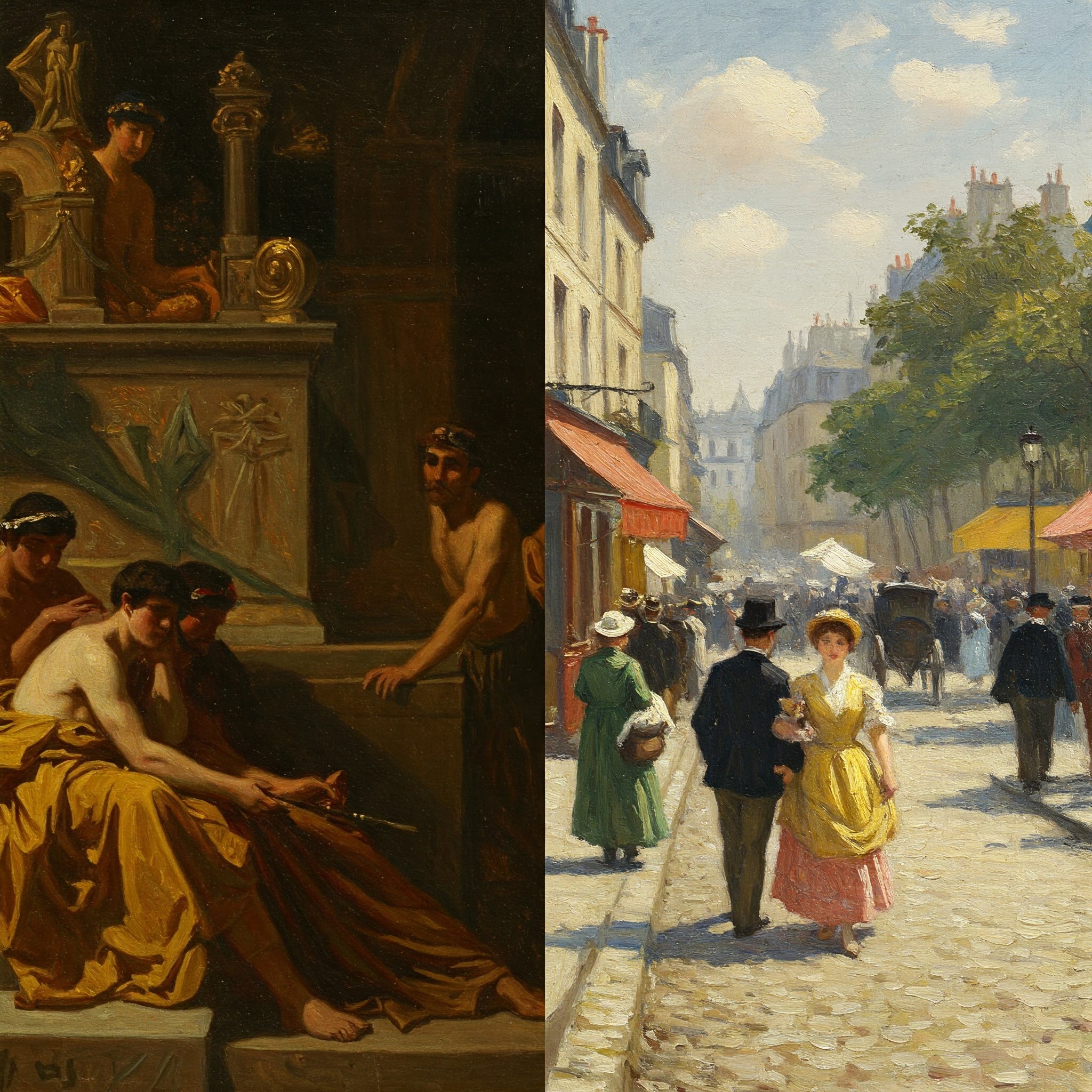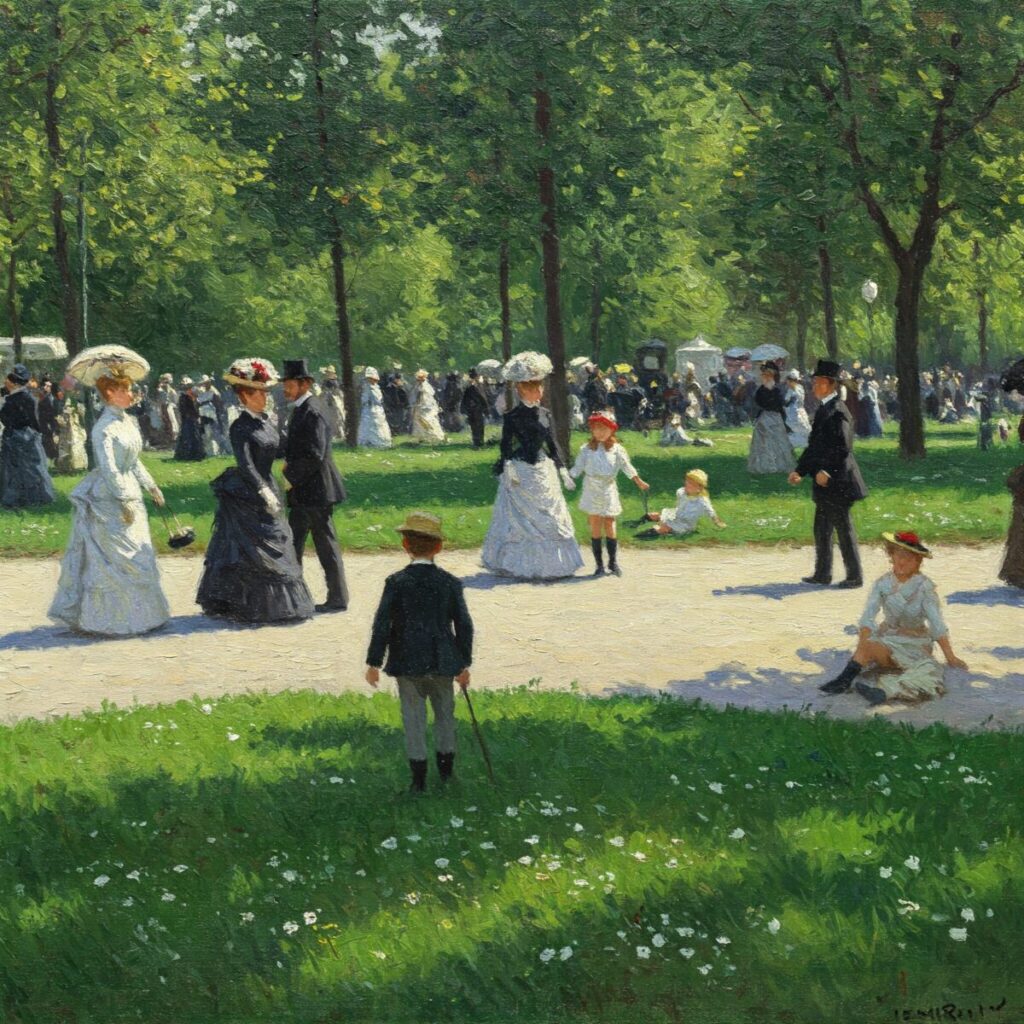Have you ever wondered what makes a painting “impressionist”? Impressionism was an exciting art movement that completely changed how artists painted in the late 1800s. The key Impressionist art characteristics include vibrant color palettes, visible brushstrokes, and an innovative focus on capturing light and its effects. Instead of creating perfect, detailed pictures inside stuffy studios, impressionist artists took their canvases outdoors to capture colorful moments of everyday life. These distinctive Impressionist art characteristics created a fresh, vibrant style that shocked the art world but eventually became one of the most beloved painting styles of all time.
Key Points:
- Impressionism began in France in the 1860s-1870s as a rebellion against traditional art rules
- Key characteristics include visible brushstrokes, emphasis on light and color, outdoor painting, and everyday subjects
- Famous impressionists include Claude Monet, Pierre-Auguste Renoir, Edgar Degas, and Berthe Morisot
- The style captures fleeting moments rather than permanent, detailed scenes
- Impressionism influenced nearly all modern art movements that followed
The Birth of Impressionism: Breaking the Rules

In the mid-1800s, art in France followed strict rules. The official art world, controlled by the Paris Salon, favored perfectly finished paintings of historical scenes, myths, or religious stories. But a group of young artists had different ideas.
When these artists tried to show their new style of painting at official exhibitions, they were often rejected. In 1863, so many artists were turned away that Emperor Napoleon III created the “Salon des Refusés” (Exhibition of the Rejected) where these new works could be shown.
One painting that caused a huge stir was Édouard Manet’s “Luncheon on the Grass,” which showed modern people in a casual outdoor setting instead of the expected historical or mythical scenes. While not technically an impressionist painting, it helped pave the way for the movement.
The First Impressionist Exhibition
In 1874, a group of these rejected artists organized their own independent exhibition. One critic mockingly called them “impressionists” after seeing Claude Monet’s painting “Impression, Sunrise,” saying it was merely an “impression” of a scene rather than a proper painting. Instead of being offended, the artists embraced the name.

Main Characteristics of Impressionist Art
Light and Color: Capturing the Moment
Impressionists were obsessed with light. They noticed that colors and appearances change depending on the time of day, weather, and season. Instead of mixing colors to create exact shades, they placed dots or dabs of pure color side by side, letting your eyes blend them from a distance.
“When you go out to paint, try to forget what objects you have before you, a tree, a house, a field or whatever. Merely think, here is a little square of blue, here an oblong of pink, here a streak of yellow, and paint it just as it looks to you…”
Claude Monet
This focus on light meant that shadows weren’t just darker versions of objects but contained blues, purples, and other unexpected colors. Monet even painted the same subject (like haystacks or the Rouen Cathedral) many times at different times of day to show how light transformed them.
Brushwork: Quick and Visible
If you look closely at an impressionist painting, you’ll notice the brushstrokes are visible and often applied quickly. Unlike traditional paintings where brushstrokes were carefully blended to create a smooth surface, impressionists used:
- Short, broken brushstrokes
- Thick paint (called “impasto”)
- Dabs and dots of color
- Loose, sketchy techniques
This gave their paintings a fresh, spontaneous feeling—like they had just captured a moment before it disappeared.
Plein Air Painting: Taking Art Outdoors

One of the most revolutionary aspects of impressionism was “plein air” painting—creating art outdoors rather than in a studio. Before impressionism, artists might make quick outdoor sketches but would complete their formal paintings indoors.
New portable paint tubes (invented in the 1840s) made this possible, allowing artists to carry their supplies to gardens, riversides, and countryside locations. Painting outside helped impressionists capture the changing effects of natural light and weather.
Learn more about plein air painting techniques at our dedicated guide
Everyday Subjects: Finding Beauty in Modern Life

Instead of grand historical scenes or religious themes, impressionists painted:
- Cafes and city streets
- Parks and gardens
- People enjoying leisure activities
- Dancers, shoppers, and workers
- Landscapes and water scenes
They captured the energy and excitement of modern life in Paris and surrounding areas, showing ordinary people doing everyday things.
The Great Impressionist Artists
Claude Monet: Master of Light
Claude Monet (1840-1926) is perhaps the most famous impressionist. His series paintings of water lilies, haystacks, and the Rouen Cathedral show his fascination with how light transforms subjects throughout the day. His garden at Giverny became both his home and his most beloved subject in his later years.
Explore Monet’s most famous works in our detailed guide
Pierre-Auguste Renoir: Painter of Joy
Renoir (1841-1919) captured the happiness and beauty of everyday life. He was especially known for painting people enjoying themselves at parties, dances, and outdoor cafes. His paintings have a warm, glowing quality that makes viewers feel like they’re part of the happy scene.
Discover more about Renoir’s influence on modern art
Edgar Degas: Movement and Modern Life
While Degas (1834-1917) exhibited with the impressionists, his style was somewhat different. He was less interested in outdoor scenes and more fascinated by artificial light and indoor subjects, especially ballet dancers, racetracks, and cafe singers. He captured movement and unusual angles that showed the influence of photography.
Female Impressionists: Breaking Barriers

Women artists played an important role in impressionism despite the limitations they faced in the art world. Berthe Morisot (1841-1895) and Mary Cassatt (1844-1926) were respected core members of the impressionist group.
Because women weren’t allowed to frequent many public spaces like cafes or work outdoors unaccompanied, female impressionists often focused on domestic scenes, portraits, and private gardens. Their work gives us a unique window into private family life during this time.
Explore our article on influential female painters throughout history
Why Was Impressionism Revolutionary?
Comparison: Academic vs. Impressionist Art
To understand why impressionism was so shocking to people at the time, let’s compare it to traditional academic painting:

| Academic Painting | Impressionist Painting |
|---|---|
| Smooth surface with invisible brushstrokes | Visible, broken brushstrokes |
| Careful drawing and planning | Spontaneous, direct application |
| Muted or controlled color palette | Bright, vibrant colors |
| Historical, mythological subjects | Modern, everyday subjects |
| Created indoors in studios | Often painted outdoors |
| Sharp details throughout | Focus on general impression, less detail |
| Dark backgrounds and shadows | Colorful shadows showing reflected light |
Public and Critical Reaction
When impressionist paintings were first exhibited, many critics and viewers were shocked and even angry! They called the works “unfinished,” “sloppy,” and “just sketches.” Some people thought the artists simply didn’t know how to paint properly.
Over time, however, private collectors began buying impressionist works, and eventually, the style became enormously popular. Today, impressionist paintings are among the most beloved and valuable artworks in the world.
Influences on Impressionism
Several factors helped shape the impressionist movement:
- Japanese Prints: When trade opened with Japan in the 1850s, colorful Japanese woodblock prints became popular in France. Impressionists were inspired by their flat areas of color, asymmetrical compositions, and unusual viewpoints.
- Photography: The new medium of photography was changing how people thought about capturing moments in time. It influenced impressionists to explore new ways of framing scenes and capturing fleeting moments.
- Scientific Discoveries About Color: New theories about how the eye perceives color influenced how impressionists used complementary colors to create vibrant effects.
The Legacy of Impressionism
Impressionism opened the door for nearly all modern art movements that followed. Its emphasis on the artist’s personal vision and freedom from strict rules paved the way for:
- Post-Impressionism (Cézanne, Van Gogh, Gauguin)
- Fauvism (Matisse)
- Expressionism
- Abstract art
Discover how impressionism influenced later art movements
How to Identify Impressionist Paintings
Want to spot an impressionist painting? Look for these key features:
- Visible brushstrokes that don’t try to hide the painting process
- Vibrant colors used in unexpected ways, especially in shadows
- Outdoor scenes with natural light effects
- Modern life subjects from the 1860s-1890s
- Feeling of movement and spontaneity rather than posed stillness
- Focus on the overall “impression” rather than tiny details
Learn to identify other painting styles in our comprehensive guide
Conclusion: Why Impressionism Still Matters
Impressionism reminds us to notice the beauty in everyday moments—how light dances on water, how colors change throughout the day, how ordinary scenes can be extraordinary if we really look at them. The impressionists taught us to see the world with fresh eyes.
Their revolutionary approach to painting—focusing on personal vision rather than strict rules—changed art forever. Even though impressionism began almost 150 years ago, its influence continues in how we think about and create art today.
The next time you see an impressionist painting, try standing back to see how the separate brushstrokes blend together from a distance, just as the artists intended. And maybe, like the impressionists, you’ll be inspired to notice the play of light and color in your own everyday world.
Explore a complete list of impressionist artists with their biographies



